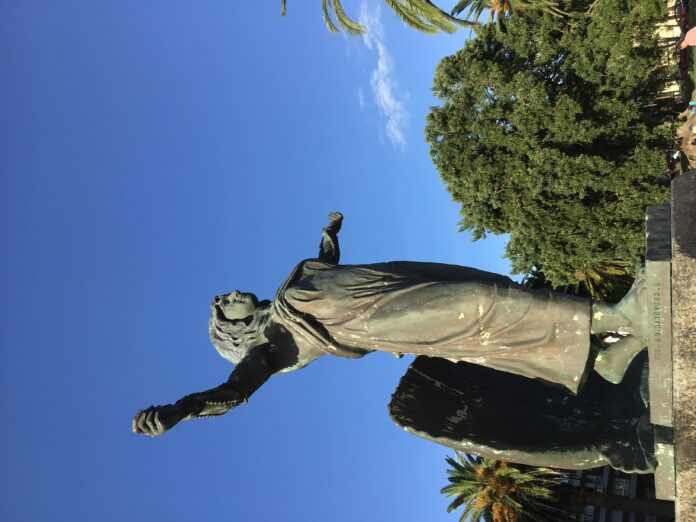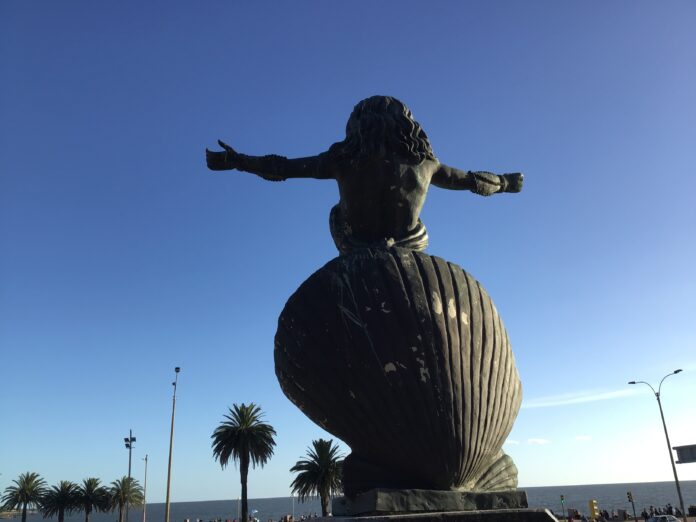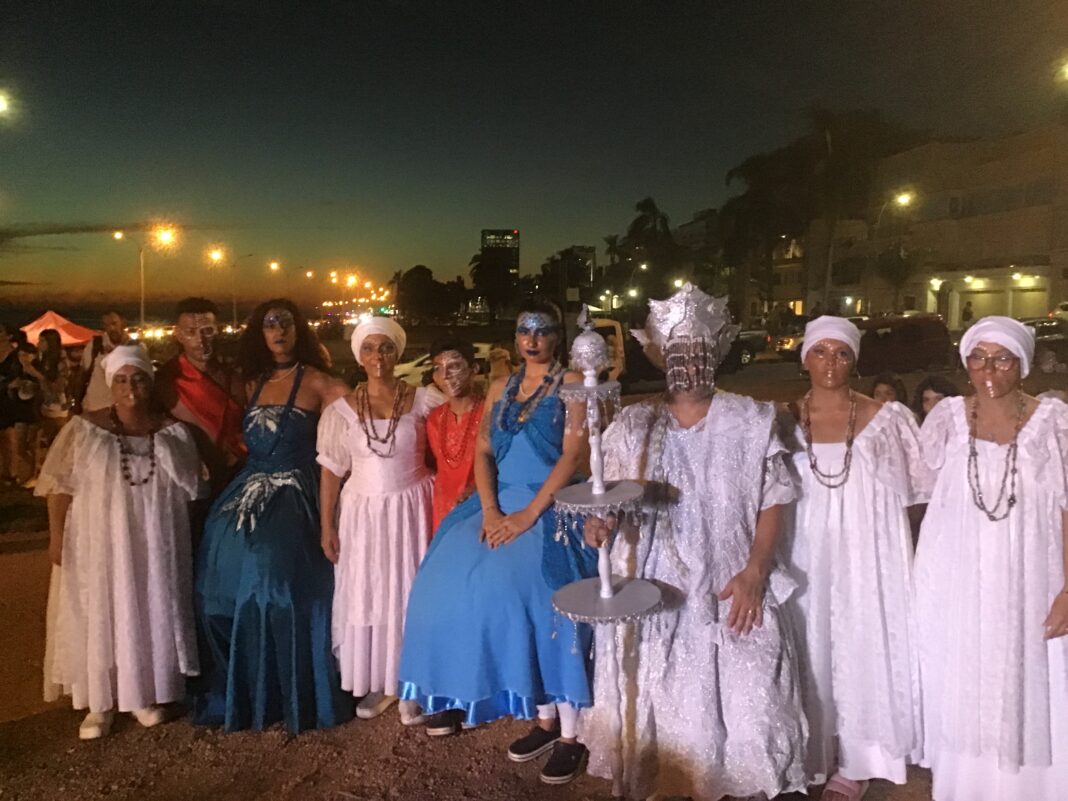By Eric van de Beek
Every year on 2 February, Uruguay’s beaches are crowded with people celebrating the birthday of the water goddess Yemanya. She’s from Africa, but the Uruguayans who venerate her are mostly white. Some see in her Mary, the mother of Jesus. A report.
Montevideo, Uruguay – It is late in the evening. I am waist-deep in the Rio de Plata and all around me are white flowers, carnations by the looks of it. Behind me, on the beach, I hear African drumming and singing. On either side and in front of me, I see people in white robes and head coverings launching homemade boats, most no bigger than four shoeboxes glued together. The boats contain fruit, candles, flowers, perfumes and jewellery. There is a strong current, which causes the boats to drift quickly. Some are equipped with decorative lights, so they remain visible for a long time. The people in the white robes are followers of the water goddess Yemanya. The boats with contents and also the white carnations are meant as gifts to her. When the boats have disappeared from sight, the followers slowly return to the beach, solemnly, walking backwards, still facing the sea.
The Ramirez beach is crowded with people. Many of them sit around pits they have dug and in which candles are burning. Most do not seem to be followers of Yemanya. They are wearing casual clothes. But that may be a misunderstanding. In four places, they are lined up in long rows, waiting to get into contact with persons dressed in sacred robes. They appear to be priests or medicine men and women performing some kind of cleansing ritual. They scan with their hands the whole body of those standing before them, from top to bottom and back again. In complete silence. By the looks of it, there is no need to pay. The treatment is free. Meanwhile, there is a lot of drumming and singing. I see a woman spinning wildly on her own axis. This is to get into a trance and become possessed by spirits, I understand later. When it’s my turn as a participatory observer, the priest seems particularly attentive to my belly. For he shakes it a few times with his flat hand.
A young woman I speak to, who describes herself as Catholic, says she offered a carnation to Yemanya. This is because the river goddess reminds her of Mary, the mother of Jesus. She is also the patroness of sailors and fishermen, and a few other nice things, she explains to me. Apart from this, she wants nothing to do with the Umbanda religion. The followers of Yemanya sacrifice animals, and she does not like that. You have to watch out for that. But if you are baptised in the church, you have good protection against that.
On the day before the Yemanya celebration, as I enter a lunchroom, I see, on a television that is on there, an interview with a diva-like apparition: a middle-aged African-American woman, in a long white dress, waving herself cool with a white fan. I only catch the last part of the conversation, but I understand from her words that I definitely have to be at Montevideo’s city beach the next day, Playa Ramirez. When I get there, I don’t see her, but her name I have remembered: Susana Andrade. She turns out to be a household name in Uruguay. She owes this mainly to her efforts to emancipate adherents of the Umbanda faith and related religions in the country who have felt ignored and ridiculed for decades. She represents the advocacy group Institución Federada Afroumbandista (IFÁ), of which she is a founder. In 2015, she won a seat in Uruguay’s parliament. This made her the first “afro-umbantista” as well as the first black woman in that seat. Together with her husband, Julio Kronberg, she runs a temple where they practice their faith and work for the community. When I contact her, she is happy to explain to me what the Umbanda religion is about.

Uruguay has several natural religions that came over via neighbouring Brazil, she says. But its origins lie with the Nigerian Yoruba tribe in Africa. Of the Afro-Brazilian religions, Umbanda is the most influential, both in Brazil and Uruguay. The Umbanists believe that orixás exist. These are a kind of nature spirits you can invoke. Yemanya and Oxalá are the main two. Yemanya, according to Andrade, is “the mother of almost all orixás”. This has to do with her being the goddess of the sea, rivers and streams, and also with the idea that without water there is no life. “Life comes from water. That source of life, that of nature, is what we honour.” Yemanya, Jemanya, or jemaja is a corruption of the expression “Yey Omo Eja”, which means something like “Mother whose children are fish”.
“Yemanya is always there,” Andrade says. “But February 2 is a special day, when we celebrate her birthday. That’s when people all over Uruguay flock to the water. There is talk of half a million, including the people who only come to watch. The background to this happening on 2 February and not any other day is that there was no place for African nature religions in Catholicism. Enslaved Africans had to conform to Catholicism. This created a fusion of orixás and ancestral spirits with Catholic iconography. Yemanya became Mary and Oxalá became God. February 2 in Uruguay is not only the Yemanya celebration. That day is also traditionally celebrated the Catholic feast of the Virgin Mary, or the Virgin of Candelaria. Thus, enslaved people could use the Marian celebration to honour Yemanya.

I noticed on the beach that the vast majority of Umbanists are white. While there are far fewer black people than white people living in Uruguay, Umbanda is an Afro-Brazilian religion. So how can that be? “That could be because historically, white people had more freedom and people with African ancestry were forced to worship the Catholic saints and forget their own faith, for fear of torture or death,” Andrade says.
I tell her about the priests I saw at work on 2 February on Ramirez beach. What were they doing? “What you saw were the fathers and mothers of Afroumbandista,” she says. “They were helping people who came for the reception of ‘charity’ or ‘santiguado’, for the purification of their aura, their etheric body.” She finds the aversion from Christians to Afro-Brazilian religions hard to understand, because evil spirits are not invoked in Umbanda, she says, rather they are exorcised.
A Uruguayan I tell about my adventures on the beach asked me if I thought the cleansing ritual on the beach had brought me something. I replied that I do not know, but in any case I did not detect anything of a change in my mental or physical functioning.
In a little square not far from the beach, I recently noticed a statue. A young woman in a long robe appearing to emerge from an oyster, her arms open, holding in her right hand two seahorses. Full breasts, wide hips. That had to be Yemanya, and indeed she was. Really different from the saintly images of Mary in whom her feminine forms are not really expressed. It is clear to me now: Yemanya is not Mary.
Book by Susana Andrade available on Amazon: MACUMBEROS: Ritos Afroumbandistas para Salud Espiritual, Prosperidad y Bienestar
Susana Andrade on television programme on February 1: https://www.youtube.com/watch?v=wOZQwOWrVGY



